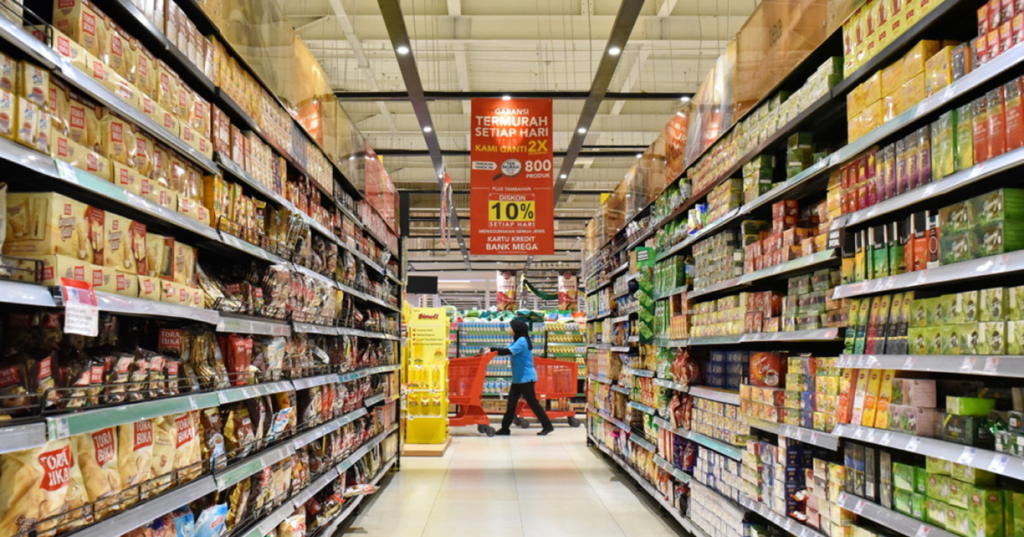
Adapting to Indonesia’s Post-Hypermarket Era
by: Regawa Paramasiddi
The Rise
It was around 2015, and I remember discussing with friends how much simpler grocery shopping used to be. Back in the 80s and 90s, family trips to supermarkets like Hero, Gelael, and Tip-Top were a common weekend activity. These were simpler times, before the rise of the hypermarket that dominated the grocery landscape.
These massive 5,000-10,000 square meter behemoths promised a one-stop shop for everything – groceries, electronics, clothing, even bicycles. And despite the emergence of Alfamidi with its oversized minimarket concept, I really thought I had seen the end of supermarkets.

The Fall
The landscape, however, soon shifted dramatically. The emergence of e-commerce giants like Tokopedia and Shopee, offering convenience and a vast selection at your fingertips, began to erode the dominance of hypermarkets. Consumer behavior shifted, favoring smaller, more frequent grocery shopping trips and a renewed focus on fresh, locally sourced produce.
This decline has had a significant impact on the retail landscape. Many shopping malls, built around these giant anchor tenants, are now struggling to fill the giant spaces that are now left vacant. Pun intended, of course. The loss of the hypermarket’s “magnet effect” has severely impacted foot traffic, leaving smaller tenants to suffer the most.
And just like that, supermarkets are back in business, and my grocery shopping experience now feels like the 1990s. Nonetheless, these supermarkets are adapting, focusing on fresh produce, offering personalized services, and embracing digital technologies to stay relevant in this ever-changing market. The particular focus on fresh produce has been evident, as more minimarkets are now offering fresh vegetables and fruits.
The Hypermarket-Centric Shopping Centers
According to Euromonitor, Indonesia witnessed a peak of 346 hypermarkets in 2018, a number that has plummeted to 249 by 2023. While the decline of hypermarkets has been a gradual process, the exit of Carrefour in 2013 can be seen as an early indicator of the challenges facing this retail format, despite CT Corp continuing to use the brand until 2021. Giant’s departure followed, and some former Hero supermarkets, previously rebranded as Giant, have reverted to the Hero name.

These hypermarket-centric shopping centers faced several critical challenges that present day shopping center management teams can learn from:
- Over-reliance on a single tenant: In these centers, the hypermarket often occupied majority of the space, leaving little room for diversification and making it incredibly difficult to find suitable replacements swiftly.
- Lack of capital for redevelopment: Many lacked the necessary funds for major renovations, hindering their ability to adapt quickly to the changing market. This proves how important it is for a shopping center to set aside a CAPEX reserve.
- Limited strategic planning: These malls often lacked dedicated leasing and strategic teams. This meant a slow response to the changing market, unlike larger, more diversified one-stop shopping malls with dynamic leasing teams that constantly analyze tenant mix and adjust their offerings.
Larger, more diversified one-stop shopping malls have shown greater adaptability. They can subdivide large spaces left by the hypermarket and introduce new mini-anchors, leveraging the demand for large spaces from the likes of Uniqlo, H&M, and Oh!Some.
The Repurpose Potential
A prime example of successful adaptation is Trans Studio Mall Makassar. While not directly related to a hypermarket closure, their renovation involved replacing the massive Trans Studio theme park with a smaller Trans Snow World and a mix of new tenants, 100 of them. Some of the new tenants are major brands that take up significant floor spaces like Zara, Oh!Some, and Miniso.
Repurposing hypermarket-dominant shopping centers presents a greater challenge. The departure of the hypermarket often erodes the retail center’s very identity. However, successful transformations are possible. Following the closure of Giant hypermarket in Kota Harapan Indah, the building was repurposed by featuring a smaller Grand Lucky supermarket, a large seafood restaurant, and a variety of eateries.
Other creative repurposing ideas could include utilizing the vacant space for sports facilities. The growing popularity of indoor lifestyle sports activities like padel, golf simulators, and even tennis simulators presents exciting opportunities. Concepts like Indonesia Sports Theme Park at Mall of Indonesia, Skorz at fX Sudirman, and VS Challenge at AEON Deltamas demonstrate the ability of these facilities to attract foot traffic and their potential to help revitalize large mall spaces.

The once-dominant hypermarket-centric shopping centers now stand as empty shells of their former glory. From conversations with some of the owners, it’s clear that their experiences have left them deeply hesitant, unwilling to risk further investment in rejuvenating these spaces. But can investors reimagine an entirely new potential for these properties and breathe new life into them? Could innovative, out-of-the-box ideas transform these dormant structures into thriving spaces once again?